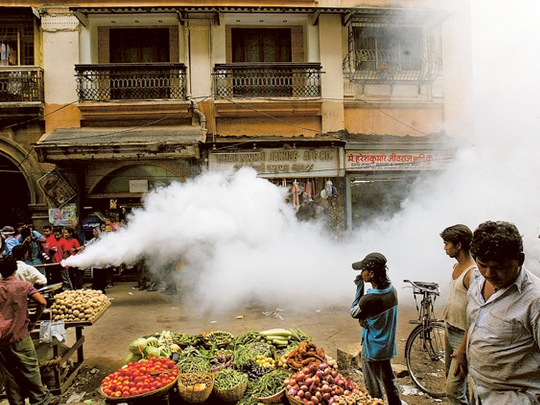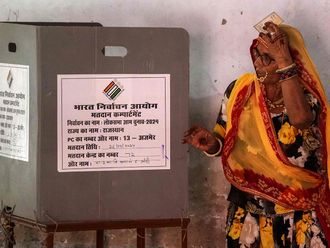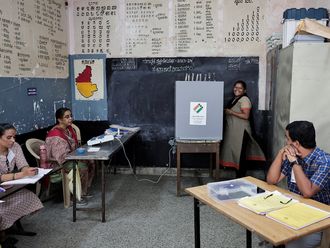
Mumbai: Indians take to the streets in celebration as monsoon clouds burst open each June. Heavy seasonal rains are a welcomed relief from intense summer and, importantly, they recharge drinking water supplies that dip to drought levels in the dry months.
But although most people celebrate the monsoon, prolonged wet weather presents public health concerns. Malaria and dengue fever are rampant during this season as mosquitoes the transmitters of these tropical diseases breed in flooded areas.
In Mumbai, the number of malaria cases spiked to 775 in just five days in 2010. The press deemed it “malaria mayhem”, and by the end of the year, the city had more than 76,000 people infected. The municipal corporation decided it was time to act and set a goal to reduce the number of malaria cases by 80 per cent. In just three years, their strategic approach has hit the target, and the programme has stood out as a nationwide model.
Many factors contributed to the high number of cases, including weather, poverty and geography. “Mumbai is a hotspot of vector-borne diseases owing to its unique environment and demography,” says Dr Sumedh Kulkarni, a fellow at a Mumbai-based public policy thinktank, the Observer Research Foundation (ORF), which partnered with Mumbai’s municipal corporation to design and implement the intervention. Densely packed slums cover 60 per cent of the city, and these areas are always disproportionally impacted. Although their infection rates are high, many communities are rarely in a position to afford anti-malarial drugs, spray with repellent or use mosquito nets. A study on malaria interventions in Mumbai slums found that in an area of Parel, a central part of the city, 90 per cent of residents live below the poverty line and cannot afford preventive measures against malaria.
Given the diversity of challenges in the city, Kulkarni says one of the key aspects of the malaria prevention and diagnosis intervention was micro-mapping and micro-planning vulnerable slum areas and construction sites. “This intervention mapped each household, targeting them for screenings and investigations. This has been the most Herculean task and it has been completed successfully,” explains Kulkarni. Going door-to-door, city officials screened households, held Sunday screenings to reach labourers and regularly sprayed potential breeding areas. If cases were detected, patients were referred to response-ready hospitals and clinics, and public health officials kept tabs on patients to ensure follow through on treatment and to prevent relapses.
On-the-ground efforts were complemented by a wide-spread awareness campaigns that were created in 2010 as Fight the Bite. “For the first time in history, the IEC [Information, Education and Communication] was considered to be an important part of the campaign and specific budgetary provisions were made,” says Kulkarni. ORF devised the communications campaign, which included posters plastered across the city as well as one-minute videos played on TV and at the cinemas. The 2014 campaign features a superhero, Mosquito Man, to target new audiences, including school children.
Creative messaging has been the key to keeping the public on alert. This year, the World Health Organisation added to the reach by partnering with Mumbai’s world-renowned dabbawalas the lunchbox deliverers who transport 200,000 home-cooked meals a day. The lunchboxes will now have small tags with messages about malaria and dengue prevention. “There will definitely be more awareness among my fellow Mumbai citizens now due to our efforts. We have literally forced them to read our messages,” said Raghunath Medge from Nutan Mumbai Tiffin box suppliers in The Hindu earlier this year.
Following the successful campaign against malaria, the city has turned its attention to dengue fever, which has been on the rise. As another mosquito-borne disease, the city is looking at how it can apply the malaria intervention toward dengue. While both are transmitted by mosquitoes and proliferate in the monsoon, there are also key differences. For example malaria breeds in the slums, while dengue is found most often in high-rise buildings.
Reducing monsoon illnesses goes beyond spraying and preparing hospitals. The city needs to clear storm drains to avoid water logging and filling potholes where water collects and pools. At the beginning of June, city officials assured the public that it had prepared Mumbai for the monsoons, but the first downpour brought severe flooding. Similarly, a comprehensive waste management plan would reduce drain blocking and breeding grounds around trash piles.
A report to be released by ORF later this year will assess the malaria programme. The model is one that can be replicated around the country, but sustainability is key, including regular review of processes and procedures. Mumbai’s anti-malaria programme shows that proactive interventions can not only prevent infections but can also quickly deal with cases that come in. Most importantly, the city has proven its ability to quickly devise and implement a coordinated public health strategy, proving that political will mixed with civic collaboration can achieve remarkable results.












